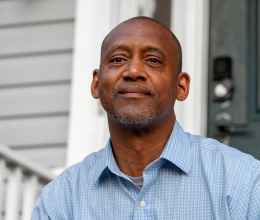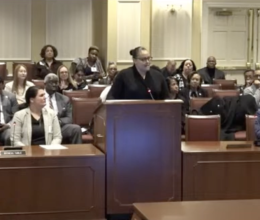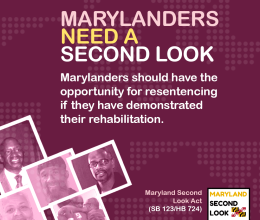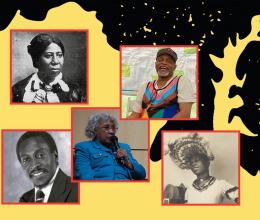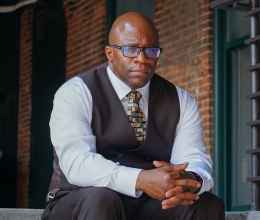

At the Baltimore Brothers Organization, Anthony Muhammad provides manhood training classes to young folks, empowering them to make positive life decisions. Wayne Brewton-Bey leads victim awareness programs in Baltimore, bringing survivors and perpetrators together for mediation, reconciliation, and forgiveness. Desmond Haneef Perry works as a peer recovery specialist with various organizations around the state. Incarcerated as teenagers, these men – like thousands of other Marylanders – returned to their communities after serving excessively long sentences. Today, they’re demonstrating growth by serving others through reentry support, community advocacy, and mutual aid.
It is devastating that they were kept from helping our communities for decades, despite years of obvious growth and substantial work behind prison walls. Sadly, no path currently exists in Maryland for people who have served lengthy prison terms to petition the court to reconsider their extreme sentences based on demonstrated rehabilitation.

This disproportionately affects Black Marylanders, who make up 76% of people serving extreme sentences in the state. Right now, people serving decades in prison cannot have their sentences reviewed even if they have been rehabilitated, or because the sentence was excessive, disproportionate, or biased. Maryland will never be a place dedicated to equity or restorative justice unless this changes.
For these reasons, advocates are calling on the Maryland General Assembly to pass the Second Look Act - House Bill 853 and Senate Bill 291, versions of which have already passed in the federal government, Washington D.C., and 12 other states . The Second Look Act empowers judges to hear from people who have served at least two decades in prison and consider their growth, history, any racial bias in sentencing, and many other factors to decide whether to adjust their sentences appropriately.
Research shows that the majority of people released from custody in Maryland, particularly under early release mechanisms, do not recidivate within three years. The data is even stronger for people returning from extreme sentences. In the landmark court decision Unger v. Maryland, roughly 200 people serving life sentences, were released. Over a decade later, 96.5% have not been convicted of a new crime. The Unger outcome demonstrates the importance of reentry support, which can mitigate hardship after release and further reduce recidivism.

In February 2025, advocates, impacted families and victims gathered in Annapolis during this legislative session to call on legislators to implement the Second Look Act. Dr. Deborah G. Haskins, a survivor and victim advocate, was among them. “I want everyone in the community to have an opportunity to be their best self -- and that includes redemption,” she said. “My failures didn’t land me in prison. I had 2nd chances, and 3rds, and 4ths. Passing this bill provides justice-involved people opportunities to demonstrate in 20 years, if they work on themselves, if they can restore themselves to become a better human being, then Maryland can give them a 2nd chance.”
I work with a man named William Mitchell, who was released in April 2023 after serving 18 years in prison. He entered prison as an emerging adult, at age of 23 with a 65-year prison term ahead of him. During his incarceration, William remained committed to bettering himself and his community inside prison walls. He took every course available to him, led spiritual and addiction recovery groups, and worked to unlearn and unpack past decision-making patterns. He also made amends with the victim in his case who would later go on advocate for William’s release.

After relentless advocacy and the dedicated work of pro-bono attorneys, his team found a technical error in his sentencing that was enough to get him back in front of a judge. When the judge had the opportunity to review William’s sentence, he reduced it by 40 years. Having served nearly two decades already, William was released shortly after the judge’s decision. He now works with the University of Maryland as a Peer Recovery Specialist, guiding people away from the types of decisions that landed him in prison as a young man.
While William’s story is inspiring, it should worry us all that his incredible potential would still be locked behind bars had his attorneys never found this technical issue. There are so many people left behind bars who have similarly committed themselves to personal growth and accountability. Without Second Look, they will never be able to appear in front of a judge to make their case for release. If Maryland is to be a place where data and compassion drive policy, we cannot justify leaving these people behind.
Crossover is right around the corner. There is no better time than now to pass the Second Look Act. These reformed and deserving men and women serving sentences from decades ago need a second look. They need a second chance.

